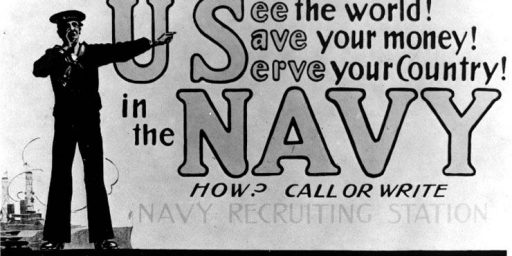Army Can’t Track Spending On Program That’s Supposed To Help It Track Spending
In a tale that seems it’s right out of Catch-22, the Army apparently cannot track spending on a project that is designed to help it track spending:
More than $725 million was spent by the Army on a high-tech network for tracking supplies and expenses that failed to comply with federal financial reporting rules meant to allow auditors to track spending, according to an inspector general’s report issued Wednesday.
The Global Combat Support System-Army, a logistical support system meant to track supplies, spare parts and other equipment, was launched in 1997. In 2003, the program switched from custom software to a web-based commercial software system.
About $95 million was spent before the switch was made, according to the report from the Department of Defense IG.
As of this February, the Army had spent $725.7 million on the system, which is ultimately expected to cost about $4.3 billion.
More than $725 million was spent by the Army on a high-tech network for tracking supplies and expenses that failed to comply with federal financial reporting rules meant to allow auditors to track spending, according to an inspector general’s report issued Wednesday.
The Global Combat Support System-Army, a logistical support system meant to track supplies, spare parts and other equipment, was launched in 1997. In 2003, the program switched from custom software to a web-based commercial software system.
About $95 million was spent before the switch was made, according to the report from the Department of Defense IG.
As of this February, the Army had spent $725.7 million on the system, which is ultimately expected to cost about $4.3 billion.
Perhaps they need a program to help them track spending on the program to help them track spending.






So no one knows how much they spend or what they spend it on or if we even needed it in the first place but the most obvious solution to some is to spend even more.
http://www.sltrib.com/sltrib/opinion/58378165-82/military-states-united-china.html.csp
Whoever is running this program is either very bad at their job, or creating some sort of in situ performance art.
In other words, we thought we could save some money buying off-the-shelf stuff….and instead, we wasted it.
Brilliant.
Featuures that enagle you to choose from rolling, smooth and turbulent waves
are required options in god wave makers.While they are often not territorial to species,
they’re able to become particularly aggtessive if they are kept in a smaller tank with other people of their species.
LED lighting is the newest lighting technology and even more superior to evwry other
lighting foor the market.
@James Pearce: Worse than that–probably a switch from one-time-purchase software to pay-by-the-month-with-extra-charges-for-updates software.
But more to my reason for posting–why am I just not surprised?
GCSS-A is not a success, but the article is somewhat misleading. You could have a perfectly useful program that lets you track supplies, spare parts, and other logistics info — and yet not have something that supports the reporting required for fully-auditable financial management. It’s sort of like the different between cost accounting and financial accounting — they’re both useful, but not at all the same thing, and not translatable from one to the other without a lot of extra information.
All of the Services are struggling mightily to implement something like the ERP (SAP, etc.) systems used in the commercial sector. The main problem is usually that the Services think they’re buying off-the-shelf software with a fixed price, and the vendors think they’re selling open-ended Business Process Re-engineering consulting services, the way they do for their commercial clients. But the Services aren’t interested in having their processes re-engineered; they just want to track the processes they already have.
Good post. I learn something new and challenging on websites
I stumbleupon everyday. It will always be useful to read articles
from other authors and practice a little something from their websites.
It’s awesome in support of me to have a website, which is helpful in favor of my knowledge.
thanks admin